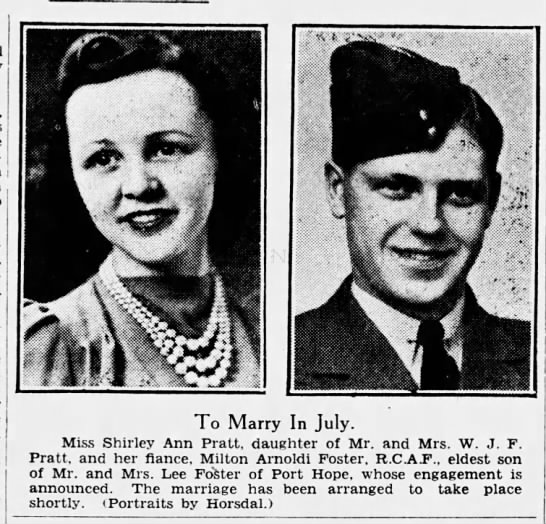
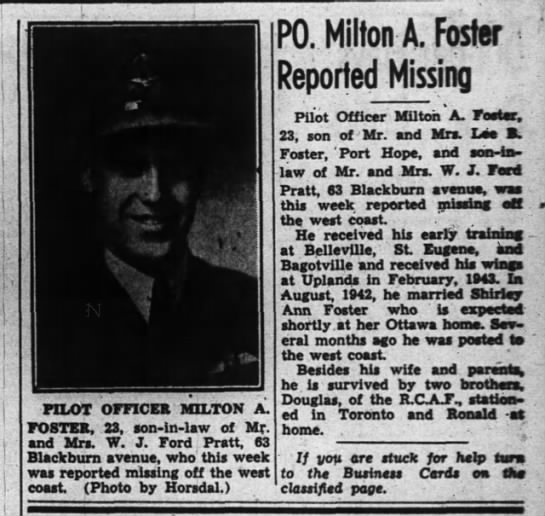

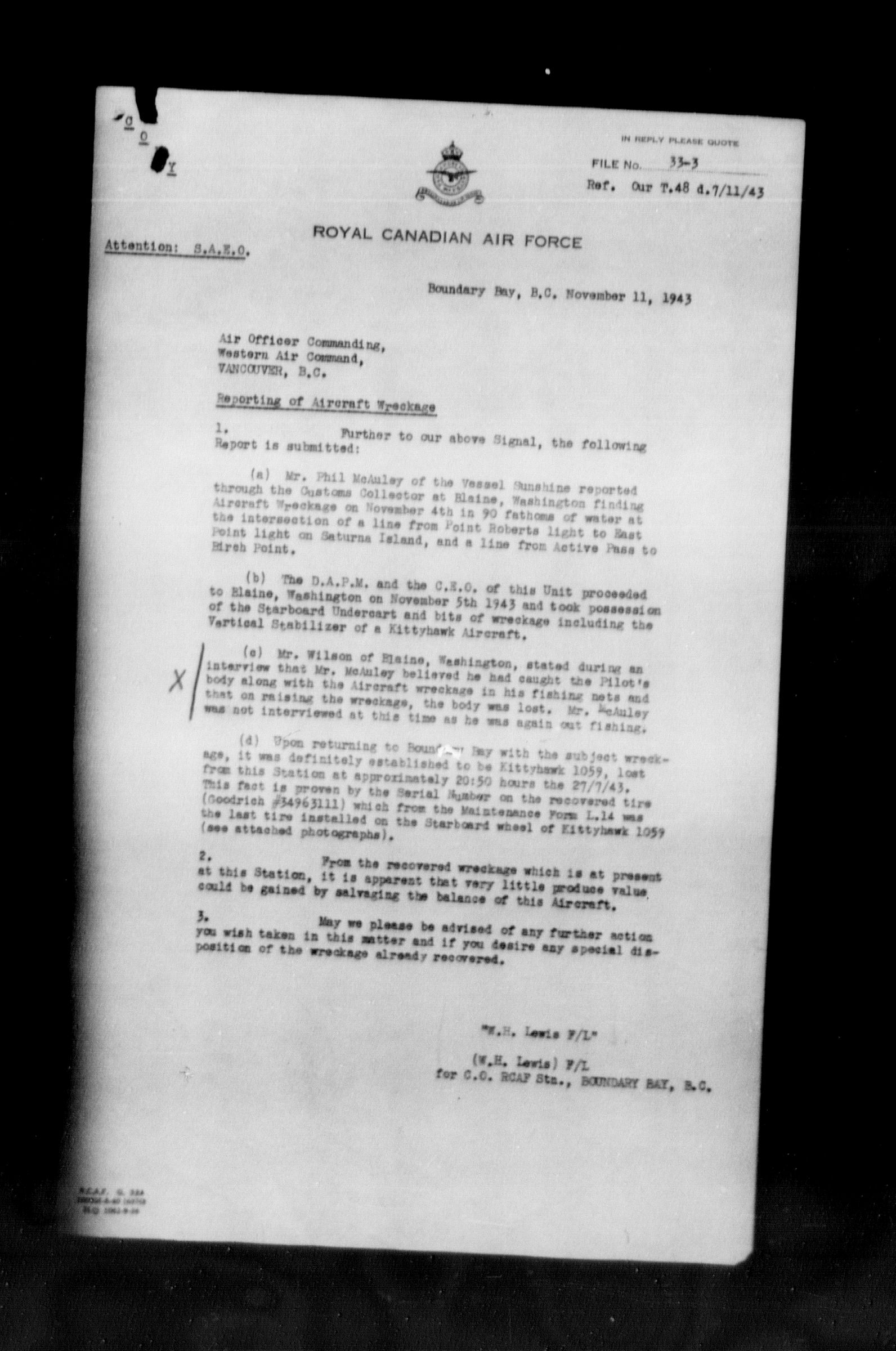
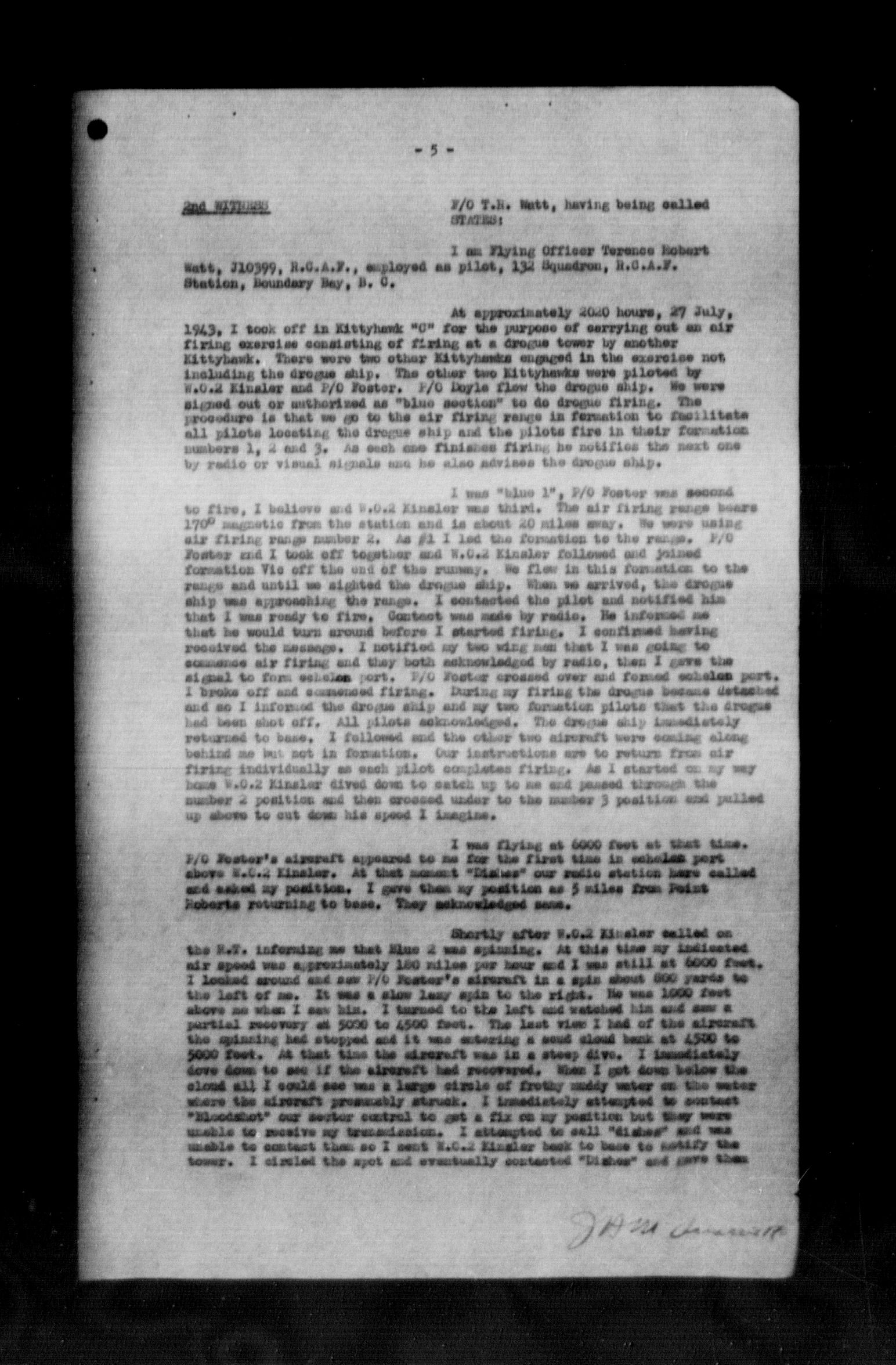
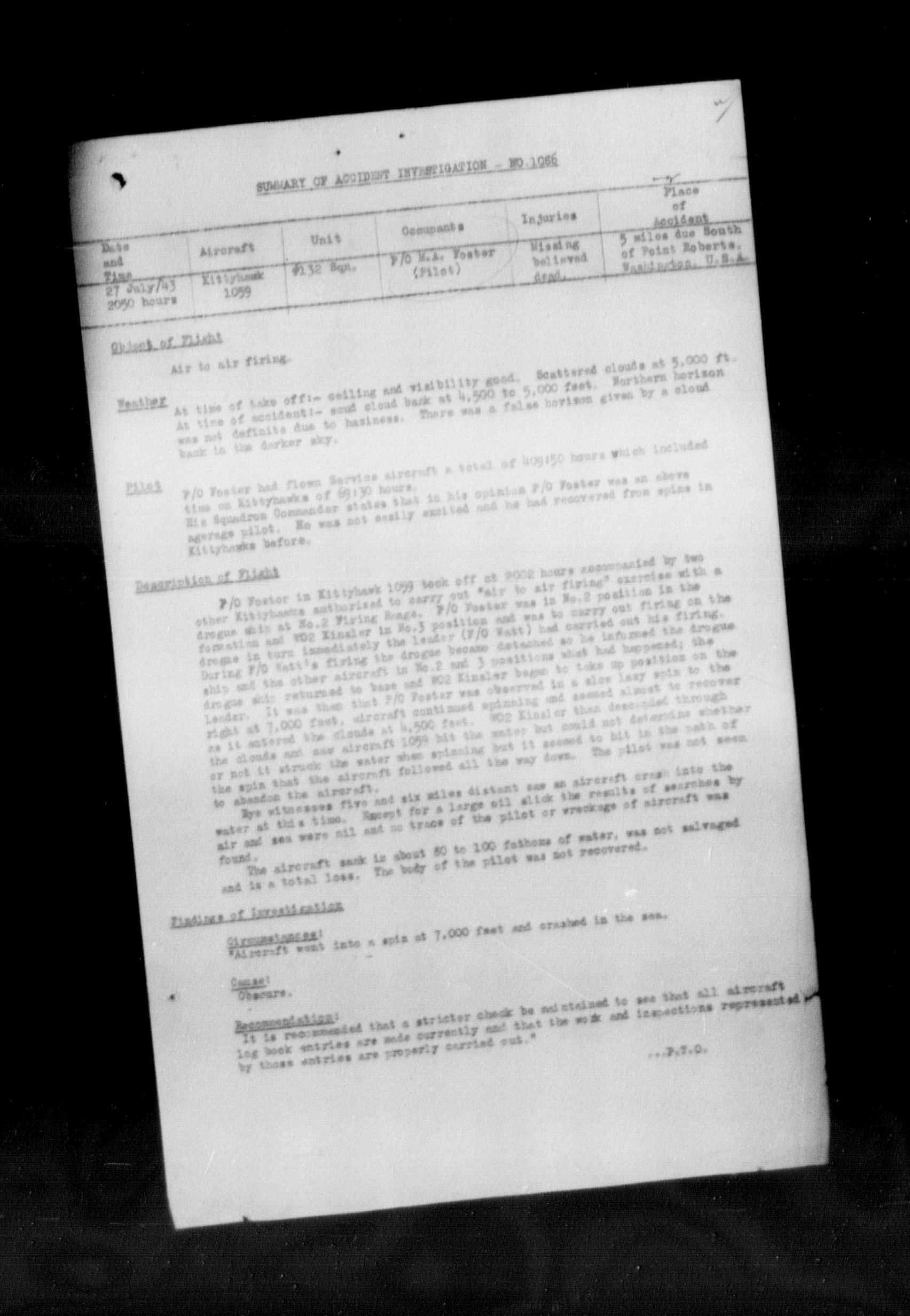
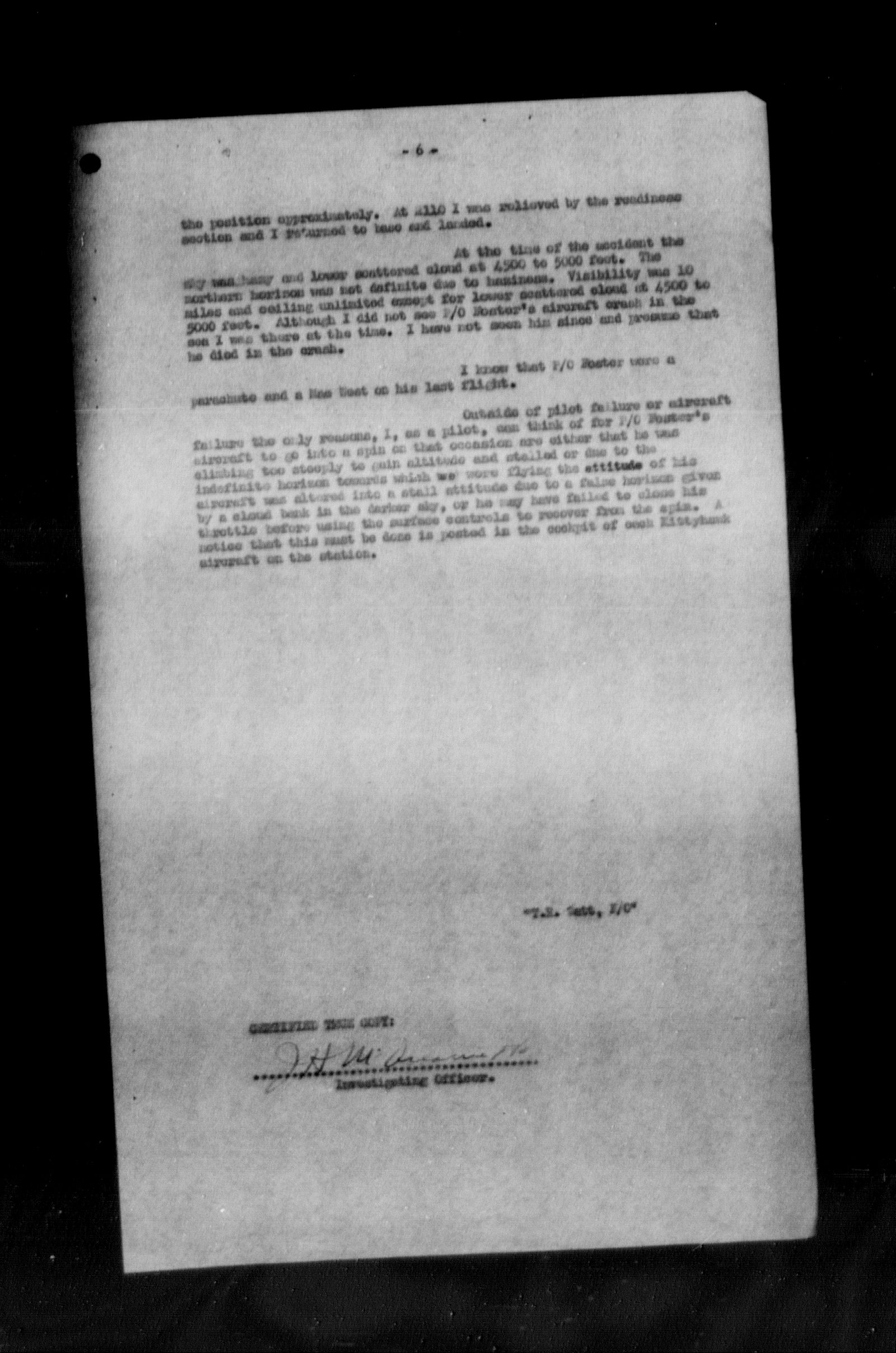
September 30, 1920 - July 27, 1943







Milton Arnoldi Foster was the son of Lee Bertram Foster, farmer, and Dorothy Isabel (nee Goodmurphy) Foster of Port Hope, Ontario. He had three brothers, Douglas Gerald Foster, also a member of the RCAF, and Ronald Ernest Foster, and a third, Keith Foster, whose death in August 1929 was “traumatic.” The family was Protestant.
He was not working when he applied to the RCAF, as he was a student when he submitted his first application in February 1939. While waiting to hear from the RCAF, he worked as a clerk at a mill and helped his father on the farm. The RCAF accepted him on September 12, 1939 at Trenton, Ontario. “Intend to remain in the RCAF as I enlisted for five years, intending to make it my career,” he wrote on his Occupational History Form. His first job with the RCAF was as an equipment assistant. He attended the Equipment Training School at Trenton from October 9 to November 18, 1939 and earned 69%. “Average.”
Milton enjoyed skating and skiing, plus photography. He did not smoke, nor drink alcohol. he stood 5’ 11’’ tall and weighed 143 pounds. He had blue eyes and fair hair.
In late December 1940. “Very good assessment of character. Superior assessment of trade proficiency. A very aggressive and efficient worker. Specializes in his trade in procurement duties. It is recommended that this NCO be promoted to the rank of temporary sergeant.” RCAF HQ Ottawa.
In March 1942, Milton wanted to become a pilot. He had just received a promotion to Flight Sergeant. “Conscientious and thorough.” March 17, 1942: “Good type. Somewhat nervous but should do well. Fit.” May 7, 1942: “Apprehensive over beginning of medical examination, hence the rapid pulse at beginning of 40 mm test. Physically fit -- intelligent. Rather high strung but stable emotionally. Excellent motivation and mental capacity.”
He was sent to No. 5 ITS, Belleville, Ontario April 26, 1942, where he was first in his class of 80 with 94.6%. “Upstanding. Sense of responsibility. Co-operative. Courteous. Steady. Very willing to learn.” Then sent was to No. 13 EFTS, St. Eugene in August. Here he was first in his class of 44 with 91%. “Should make an above average pilot at service.” While here, on September 18, 1942, Milton failed to obey Station Standing Orders in that he flew below 200 feet at 1115 hours while practicing forced landings. He was reprimanded.
From there, he was sent to No. 2 SFTS, Uplands, Ontario until March 12, 1943. Again, he was first in his class out of 66 students with 89.6%. “A confident student who progressed rapidly. Willing to work and anxioux to learn. A very smooth natural pilot. A sterling all round type.”
Milton Arnoldi Foster married Shirley Ann Pratt (1920-2007) on August 3, 1942. They had no children. She remarried in June 1945 to John Turner Weeks (1918-2014), a member of the USNR. Shirley Ann shared a joint bank account with Milton; Milton had $50 in Victory Loan Bonds and a $1000 life insurance policy with Shirley Ann, the beneficiary.
Shirley Ann lived at Hotel Commercial, Bagotville, while Milton was stationed at No. 1 O.T.U. Milton was a patient at Hotel Dieu Hospital April 27 to May 4, 1943 while at Bagotville. From May 5 to May 14, 1943, he was on sick leave, as he had his tonsils removed.
From there, Milton was sent to Western Air Command in Vancouver, BC June 19, 1943 and shortly taken on strength with 132 Squadron, Tofino, BC, where he remained until July 1, 1943. He was then taken on strength with 132 Squadron, at Boundary Bay, BC. Shirley Ann moved to Vancouver to be near Milton.
Milton had 409.50 hours experience flying a variety of aircraft. On July 27, 1943, about five miles south of Point Roberts, Washington, USA, during a training exercise in Kittyhawk 1059, Milton was reported missing, then presumed dead.
The full Court of Inquiry can be found on Microfiche T-12341, starting at image 3071. The investigating officer was F/O J. H. McQuarrie, Western Air Command, Accidents Investigations Branch. Twelve witnesses were called.
The first witness, F/L Walter Norman Douglas J2933, temporary Squadron Commander, No. 138 Fighter Squadron, Boundary Bay, BC stated that he “authorized F/O Watt, P/O Foster, and WO2 Kinsler for air-to-air firing on a drogue towed by P/O Doyle…On completion of the flight, F/O Watt and WO2 Kinsler returned to the station and reported to me that they. had seen the aircraft which P/O Foster was flying crash into the sea. P/O Foster was a pilot in No. 138 Squadron. In my opinion, he was an above average pilot. He was not easily excited. He had recovered from spins in Kittyhawks before.” [F/L Douglas died on May 14, 1945, and is buried at the Becklingen War Cemetery, in Germany.]
The second witness, F/O Terence Robert Watt, J10399, stated that “at approximately 2020 hours on 27 July, 1943, I took off in Kittyhawk ‘C’ for the purpose of carrying out an air firing exercise consisting of firing at a drogue tower by another Kittyhawk. There were two other Kittyhawks engaged in the exercise not including the drogue ship. The two other Kittyhawks were piloted by WO2 Kinsler and P/O Foster. P/O Doyle flew the drogue ship… the procedure is that we go to the air firing range in formation to facilitate all pilots locating the drogue ship and the pilots fire in their formation numbers one, 2, and 3. As each one finishes firing, he notifies the next one by radio or visual signals and he also advises the drogue ship. I was ‘Blue 1’ P/O Foster Was second to fire, I believe, and WO2 Kinsler was third. the air firing range was about 20 miles away. We were using air firing range number two. As #1, I led the formation to the range. P/O Foster and I took off together and WO2 Kinsler followed in joint formation VIC off the end of the runway. We flew in this formation to the range until we sighted the drogue ship. When we arrived, the drug ship was approaching the range. I contacted the pilot and notified him that I was ready to fire. Contact was made by radio. He informed me that he would turn around before I started firing. I confirmed having received the message. I notified my two wing men that I was going to commence air firing an they both acknowledged by radio, then I gave the signal to form echelon port. P/O Foster Crossed over and formed echelon point. I broke off and commenced firing. During my firing, the drogue became detached, so I informed the drug ship and my two formation pilots that the drogue had been shot off. I followed and the other two aircraft were coming along behind me but not in formation. Our instructions are to return from air firing individually as each pilot completes firing. As I started on my way home, WO2 Kinsler dived down to catch up to me and passed through the number two position and then crossed under to the number three position and pulled up above to cut down his speed I imagine. I was firing at 6000 feet at that time. P/O Foster’s aircraft Appeared to me for the first time in echelon port above WO2 Kinsler. At that moment our radio station here called and asked my position. I gave them my position as five miles from point Roberts returning to base. They acknowledged same. Shortly after WO2 Kinsler called on the R. T. Informing me that ‘Blue 2’ was spinning. At this time my indicated airspeed was approximately 180 mph an I was still at 6000 feet. I looked around and saw P/O Foster’s aircraft in a spin about 800 yards to the left of me. It was a slow lazy spin to the right. He was 1000 feet above me when I saw him. I turned to the left and watched him and saw a partial recovery at 5000 to 4500 feet. The last few I had of the aircraft the spinning had stopped and it was entering a cloudbank at 4500 to 5000 feet. At that time the aircraft was in a steep dive. I immediately dove down to see if the aircraft had recovered. When I got down below the cloud, all I could see was a large circle of frothy muddy water on the water where the aircraft presumably struck. I immediately attempted to contact ‘Bloodshot,’ our sector control to get a fix on my position but they were unable to receive my transmission. I attempted to call our radio station Anne was unable to contact them so I sent WO2 Kinsler back to base to notify the tower. I circled the spot and eventually contacted the radio station and gave the position approximately. At 2110, I was relieved by the readiness section an I returned to base and landed. Visibility was 10 miles and ceiling unlimited except for lower scattered clouds at 4500 to 5000 feet. Although I did not see P/O Foster’s aircraft crash in the sea, I was there at the time period I have not seen him since and presume that he died in the crash. I knew that he had a parachute and a Mae West on his last flight. Outside of pilot failure or aircraft failure, the only reasons I, as a pilot, can think of for P/O Foster’s aircraft to go into a spin on that occasion or either that he was climbing too steeply to gain altitude installed or do to the indefinite horizon towards which we were flying the attitude of his aircraft was altered into a stall attitude due to the false horizon given by a cloudbank in the darker sky, or he may have failed to close his throttle before using the surface controls to recover from the spin. And notice that this must be done is posted in the cockpit of each Kittyhawk aircraft on the station.”
WO2 Francis Kinsler, R104899, was the third witness. He concurred with Watt, adding that after F/O Watt said, “I have shot the drogue off,” he immediately turned to formate on F/O Watt. “I was about 2000 feet above him and had a pretty fast overtaking speed so I slid under him from right to left and up to lose speed. Just then I looked back and saw P/O Foster in a spin. I was at 6000 feet and he was at about 7000 feet when I first saw him in a spin and he was not more than a mile away from me. I immediately called F/O Watt’s attention to it and started circling. He continued his spin and seemed to recover just as he was entering the clouds at about 4500 feet. I lost sight of him then until I dropped down through the clouds. I just saw him in time to see him hit the water. I could not tell whether or not he was spinning when he hit or what attitude the aircraft was in. It seemed to hit in the path of the spin he had followed all the way down. I tried to contact sector to take a fix on it but didn't succeed in getting through… having seen his aircraft hit the water and not having seen him bail out, I am certain that he was killed in the crash. When he left the pilots room about 10 minutes before we took off, I saw that he had a parachute Anna Mae West on. He crashed immediately approximately 5 miles due South of point Roberts. There were a few boats on the shore at point Roberts but I did not see any as far out as the scene of the crash. When he spun down, it was a slow, lazy spin to the right.”
The fifth witness, F/L Charles Everett Baker Stewart, J8152, stated that a Stranraer and a Lysander aircraft were despatched to the scene from Patricia Bay to participate in the search. Approximately 35 minutes later, he was advised that the aircraft arrived at the position at 2133 hours. “132 Squadron aircraft remained at the scene searching until the air/sea rescue aircraft had arrived.” An American Coast Guard vessel was at the scene as well. “The search continued by air until darkness. Three marine aircraft proceeded to the scene that night and searched until 1200 hours the following day.” A large oil slick was the only evidence of the plane going into the water.
The sixth witness F/L Lewis S. Thompson, C6242, Chief Engineer Officer stated that he investigated the possibility of salvaging the aircraft. “Due to the fact that the aircraft is lying in between 80 to 100 fathoms of water and the exact location was not marked and that a heavy tide rip was running at the time of the crash, it was not thought practical and economical to carry out salvage operations.”
REMARKS OF THE INVESTIGATING OFFICER: “The evidence is that the aircraft crashed in United States waters…Discussion with pilots on the station elicited the information that it is common practice to cross the international border when proceeding to and from No. 2 air firing range. The accident in this case occurred on the return from No. 2 air firing range…no evidence was obtainable as to how F/O Foster spent the evening of 26 July. However it was learned that he was a quiet chap who neither smoked nor drank. It is believed he spent his last evening with his wife in Vancouver. Examination of P/O Foster’s medical record failed to disclose any evidence which would shed light on the accident. He had been medically examined on April 5, 1943. On 15 May 1943, he returned from sick leave after having his tonsils out and satisfactorily passed an examination. On 4 June 1943, he was found to be physically fit for overseas duties. P/O Foster had been instructed in the proper method of recovering from a spin in a Kittyhawk aircraft and there was a notice in the cockpit of Kittyhawk 1059 at the time of the accident outlining the proper procedure recovering from a spin. An attempt was made to locate eyewitnesses of the accident on the ground. The aircraft crashed 5 miles out to sea and the nearest witnesses were five miles away. Three men were located who heard the aircraft hit the water and saw the splash. They were between five and six miles from the scene and were unable to give any information of value, consequently they were not called as witnesses. While the investigating officer cannot state that the discrepancies found in the logbooks of this aircraft definitely had a bearing on this accident, nevertheless it is recommended that a stricter check be maintained to see that all aircraft logbook entries are made currently and that the work an inspections represented by those entries are properly carried out.”
Comments about the carelessness of maintenance records on aircraft at 132 Squadron were made. “Gross negligence or ignorance of the proper procedure on the part of the Unit concerned and action should be taken to rectify this situation.”
In a letter dated November 11, 1943: “Mr. Phil McAuley of the vessel Sunshine reported through the Customs Collector of Blaine, Washington, finding aircraft wreckage on November 4th in 90 fathoms of water at the intersection of a line from Point Roberts light to East Point light on Saturna Island, and a line from Active Pass to Birch Point.” The starboard undercart and bits of wreckage including the vertical stabilizer of a Kittyhawk aircraft were recovered. “Mr. Wilson of Blaine, Washington, stated during an interview that Mr. McCauley believed he had caught the pilot’s body along with the wreckage in his fishing nets and that on raising the wreckage, the body was lost. Mr. McAuley was not interviewed at this time as he was again out fishing. Upon returning to Boundary Bay with the subject wreckage, it was definitely established to be Kittyhawk 1059, lost approximately at 2050 hours on 27/7/43. The fact is proven by the serial number on the recovered tire…which…was the last tire installed on the starboard wheel of Kittyhawk 1059.”
In a memo dated November 23, 1943: “The wreckage recovered from the above-mentioned aircraft may be disposed of as owing to its condition. No evidence of any value can be gained from further examination.”
Shirley moved back to Ottawa shortly after Milton went missing. She wrote a pragmatic letter on January 26, 1944 to the Secretary, Dept. of National Defence for Air, Ottawa stating, “I have had no further word from the Officer Commanding of my husband’s Squadron so I do feel that there is little hope that [my husband’s] body may be recovered and certainly I have known all along that he is not alive.” In 1945, Shirley remarried and moved to the United States with her new husband. She passed away in 2007 in Columbia, South Carolina.